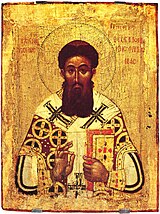

| Part of a series on the |
| Eastern Orthodox Church |
|---|
| Overview |
| Part of a series on |
| Palamism |
|---|
 |
|
|
Theotokos (Greek: Θεοτόκος)[a] is a title of Mary, mother of Jesus, used especially in Eastern Christianity. The usual Latin translations are Dei Genitrix or Deipara (approximately "parent (fem.) of God"). Familiar English translations are "Mother of God" or "God-bearer" – but these both have different literal equivalents in Ancient Greek: Μήτηρ Θεοῦ, and Θεοφόρος respectively.[4][5]
The title has been in use since the 3rd century, in the Syriac tradition (as Classical Syriac: ܝܠܕܬ ܐܠܗܐ, romanized: Yāldath Alāhā/Yoldath Aloho) in the Liturgy of Mari and Addai (3rd century)[6] and the Liturgy of St James (4th century).[7] The Council of Ephesus in AD 431 decreed that Mary is the Theotokos because Her Son Jesus is both God and man: one divine person from two natures (divine and human) intimately and hypostatically united.[8][9]
The title of Mother of God (Greek: Μήτηρ (τοῦ) Θεοῦ) or Mother of Incarnate God, abbreviated ΜΡ ΘΥ (the first and last letter of main two words in Greek), is most often used in English, largely due to the lack of a satisfactory equivalent of the Greek τόκος. For the same reason, the title is often left untranslated, as "Theotokos", in Eastern liturgical usage of other languages.
Theotokos is also used as the term for an Eastern icon, or type of icon, of the Mother with Child (typically called a Madonna in western tradition), as in "the Theotokos of Vladimir" both for the original 12th-century icon and for icons that are copies or imitate its composition.
- ^ "Theotokos". Oxford English Dictionary (Online ed.). Oxford University Press. (Subscription or participating institution membership required.)
- ^ "Theotokos". Merriam-Webster.com Dictionary. Merriam-Webster.
- ^ "Theotokos". Dictionary.com Unabridged (Online). n.d.
- ^ Ph. Schaff, H Wace Nicene and Ante-Nicene Fathers, II.XIV ("Excursus on the Word Θεοτόκος")
- ^ J.F. Bethune-Baker, Nestorius and His Teachings: A Fresh Examination of the Evidence (1998), p. 58
- ^ Addai and Mari, Liturgy of. Cross, F. L., ed. The Oxford Dictionary of the Christian Church. Oxford University Press. 2005. "Book for people in English". Kaldu.org. Archived from the original on 2013-11-06. Retrieved 2013-11-03.
- ^ John Witvliet, "The Anaphora of St. James" in ed. F. Bradshaw Essays on Early Eastern Eucharistic Prayers, 1997. "CHURCH FATHERS: Divine Liturgy of St. James". Newadvent.org. Retrieved 2013-11-03.
- ^ Cite error: The named reference
Ephesuswas invoked but never defined (see the help page). - ^ "NPNF2-14. The Seven Ecumenical Councils - Christian Classics Ethereal Library". Ccel.org. 2005-06-01. Retrieved 2012-10-04.
Cite error: There are <ref group=lower-alpha> tags or {{efn}} templates on this page, but the references will not show without a {{reflist|group=lower-alpha}} template or {{notelist}} template (see the help page).